Stretching watercolour paper
Stretching watercolour paper before you start is a wise move if there is any possibility that you might use a wet process when creating your art work. If you do NOT later use water or solvent it doesn't mater, but if you do the paper will stay smooth and not buckle.
Whether stretching watercolour paper is necessary also depends on the weight of the paper you will be using. Anything under 300gsm (140lb) is best stretched, if you are using something heavier, you may get away without doing so.
Let's first look at why a paper may need to be stretched.
Why is stretching watercolour paper necessary?
When paper gets wet it expands and then it contracts again as it dries. This can result in a buckled, wavy surface when wet media is used, especially when only part of the surface is made wet, or a large amount of liquid is applied.
To prevent this we can stretch a paper before using watercolour paint and also when using watercolour pencils if we intend to use an appreciable amount of water in our painting process.
If we are only using modest amounts of water and simply dampening the paper surface there is an easy technique for anchoring the paper so that when it distorts the paper is held and then dries back to its original flat state. We will go into more detail on this process further down this page.
Stretching watercolour paper when it is going to get wet
The aim when stretching watercolour paper is to wet it enough so that it 'relaxes' and spreads out. We then fix it down to a board and when it dries and contract again it comes under tension and stays that way while we paint.
When we add water media to the surface of the paper, that part may well expand but as the paper as a whole is still under tension from the original treatment when it was put on the board, the paper stays flat.
How wet we want to get the paper depends on its weight.
Some 300gsm papers are very strong and have the power to bend the drawing board as they dry, so in those cases it is wise to limit the amount of water and then allow time while they relax, before fixing them down.
Thinner papers may need wetting with a large brush rather than soaking in a water bath, to limit the amount of water applied. From this you will see that it is the TIME the damp paper is stretching that is crucial, rather than the amount of water used.
The 300gsm Daler Rowney Botanical paper that Peter uses needs a short water soaking treatment (usually in the bath) a further relaxing time to stretch, and it will then require fixing to the board with both wide brown paper 'Butterfly' tape and also staples. Without the staples the paper may well tear itself away from the brown paper tape as it dries.
I can't give you precise times and amounts of water as only experience will tell you the perfect combination for your paper.
In the past I tended to prepare a batch of paper to a batch of boards (all in one go) as that had a higher success rate and a lower mess rate. Fixing wet stretched paper to wooden boards in an unreliable method though.
Lately, I have tended to use a commercially made aluminium framed board that firmly holds the wet paper down at the edge and this has had a much more reliable result. The Keba Artmate is not cheap, but it easy to use and trustworthy. It comes in a range of sizes (based on the old imperial sizes). I now have a full set and find them invaluable if I need to stretch paper at a show or for a demo and have limited time.
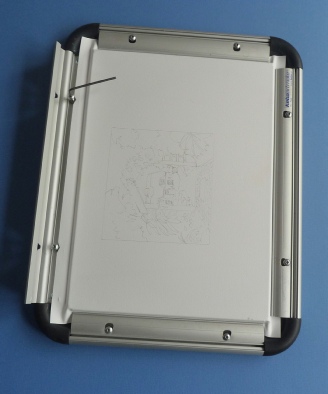
Keba Artmate Paper Stretcher
The Keba Artmate holds up to a 300 gsm (and more) paper firmly in the aluminium clamps on each side of the white, plastic surfaced board.
All the elements take apart into separate components and the sides of other Artmate board sizes can be used in combination to make square and letterbox shaped boards.
Once paper has been stretched and dried on the board, the paper can be removed dry and replaced later if required, as a heavyweight paper will take up the shape of the board surface - as can be seen to the lefthand side of the board illustrated. The fastening bolts have an inset to take an allen key. The whole is very well built and the price reflects this.
Alternatives to the Artmate
There are other commercial devices for stretching watercolour paper for sale through art materials suppliers.
Jacksons offer a paper stretcher of a simple design which looks very promising and is less than half the price of the Artmate. It has four plastic clips which hold the paper to the foam backing board - one along each side.
I purchased a couple of these boards to test and the one that takes a sheet of A4 paper was £11.40 at the time. The next larger model is the A3 (approximately 12 x 16 inches for our USA friends) and sold for £18.70. The system works well and stretches the paper securely. I have tested it on 300 gsm Fabriano and it holds it firmly. The boards are made by Educational Art & Craft Supplies.
For those who like to get their paper wet and stretch several sheets at a time, the price isn't too dear and the result more reliable than using boards and sticky tape. The only snag I can report is that the plastic clips that surround the board stand proud of the paper surface and this can be uncomfortable if you like to rest your hand along the paper edge. Possibly using a larger sheet of paper and the larger board would ensure a sufficiently wide margin around the picture edge to enable comfortable working.
When the paper is going to get damp
When the paper is only going to get damp, or wet in some areas, we may not need to go to the trouble of stretching the paper.
If we wet an area within a sheet of paper that area will expand, leaving a bump in the paper that may not return to its original flatness later.
However, if we can anchor the paper firmly to the drawing board in such a way that it can be removed later without major damage, and keep the paper under tension as it becomes moist (and expands) and then dries (and contracts) we will encourage the paper to return to a flat state.
If we use drawing pins to hold down the paper, the points where the paper is controlled are spread apart and we don't have full control. Tensions may also result in pressures from the paper tearing away the weak point where he pin is sited.
If we use double sided tape, the paper will be difficult to remove later - the control may be absolute be we could damage the drawing surface when we come to remove it from the board.
There is a middle way and this is ideal for times when we are only moistening small areas of the paper with modest amounts of colour wash, such as when we may be underpainting, or working on a relatively small area with water, softening and bedding down dry pigment into the paper.
The magic solution to this method of stretching watercolour paper is masking tape!
We need some self adhesive masking tape. The one inch wide tape works well, but is a bit fiddly to apply. The 1.5 inch tape might be easier to handle if you can get it. I have used the 1 inch variety below.
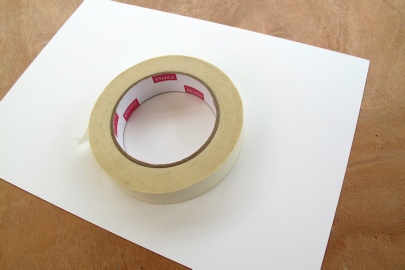
Using tape for stretching watercolour paper
Place your sheet of watercolour paper, working surface down, on the board.
First tear off a strip of tape the same length as one of the sides and affix the long edge ONLY to a line just in from the edge of the back of the paper. Roll the sticky tape over and back down to form a tube of tape with one side down on the paper and the other sticky side face up towards you. This is easier demonstrated than explained, but try it out and you should soon get the idea.
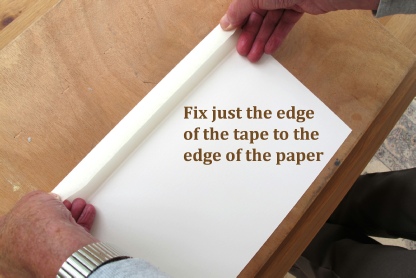
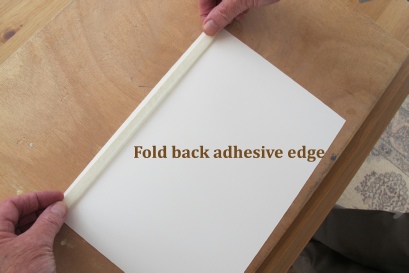
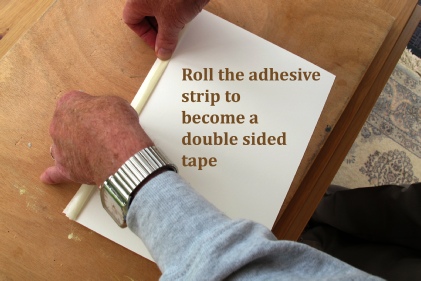
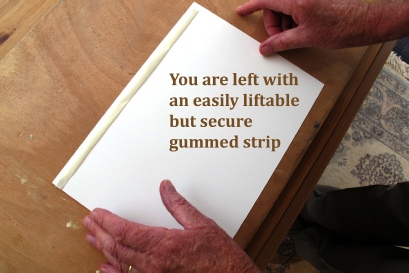
Complete the four sides of adhesive so that the paper now has four sides that will stick down to the board.
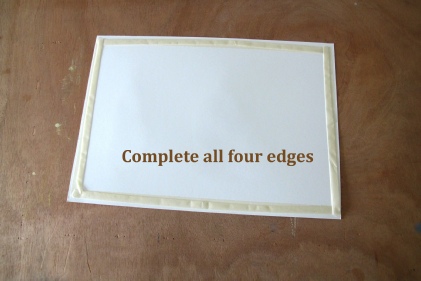
You will find that if you use a 300 gsm (140lb) paper, and moderate amounts of water when you paint your undercoat, the expanding paper surface that bulges out when you paint, will settle back down to complete flatness once it dries.
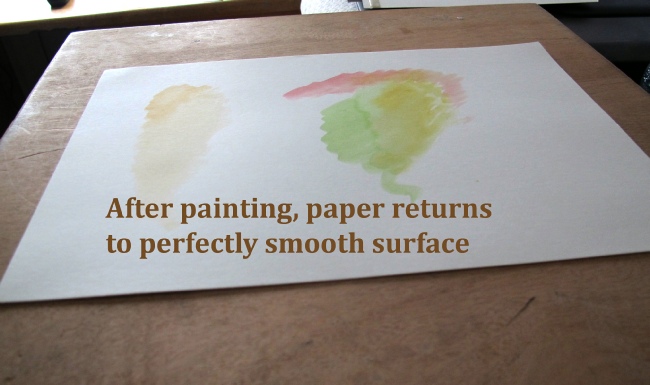
YES, you could use double sided tape for stretching watercolour paper but that is usually designed for permanent use. It will lock the paper to the board and you may find the paper tears when you try to lift it. Masking tape is designed to be lifted, but the four long strips you have added to the back of your drawing paper will resist sideways movement of the paper whilst still being removable by gently lifting afterwards.
Try it out and see how you get on...
Just make sure that you keep your painted picture to the area away from the tape - if you have a problem you may need to trim the paper afterwards. At least you will not have to trim as much as you would have done when stretching watercolour paper the traditional way.
There are no guarantees, as I have no control over your paper, board, tape or the amount of water you will use, but I find it has worked for me, and it worked for the person who showed me the method.
Experimentation is sometimes a joy and sometime a pain. I hope you find this is a joy!
- Home
- Drawing Papers
- Stretching watercolour paper


